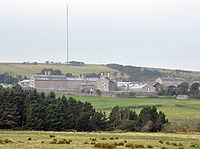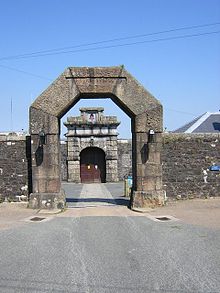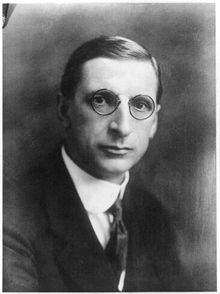- Dartmoor (HM Prison)
-
HMP Dartmoor 
Opened 1809 Management HM Prison Service Prison type Adult Male/Category C Prisoner figures 646 (December 2007) Location Princetown, Devon Governor Tony Corcoran Information www.justice.gov.uk HM Prison Dartmoor is a Category C men's prison, located in Princetown, high on Dartmoor in the English county of Devon. Its high granite walls dominate this area of the moor. The prison is owned by the Duchy of Cornwall, and is operated by Her Majesty's Prison Service.
Contents
History
Early history
Designed by Daniel Asher Alexander and constructed originally between 1806 and 1809 by local labour, to hold prisoners of the Napoleonic Wars, it was also used to hold American prisoners from the War of 1812. Although the war ended with the Treaty of Ghent in December 1814, many American prisoners of war still remained in Dartmoor.
From the spring of 1813 until March of 1815 about 6500 American sailors were imprisoned at Dartmoor. While the British were in charge, the prisoners created their own governance and culture. They had courts which meted out punishments, there was an in-prison market, a theater and a gambling room. Many of the prisoners were black Americans.[1]
On April 6, 1815, 7 of them were killed and 31 wounded when guards opened fire on inmates attempting an escape. A memorial to the 271 POWs (mostly seamen) who are buried in the prison grounds has been erected.
Dartmoor Prison was reopened in 1851 as a civilian prison, but was closed again in 1917 to be converted into a Home Office Work Centre for certain conscientious objectors granted release from prison; cells were unlocked, inmates wore their own clothes, and could visit the village in their off-duty time. It was again reopened as a prison in 1920, and then contained some of Britain's most serious offenders.
Dartmoor mutiny
On January 24, 1932, there was a major disturbance at the prison. The cause of the riots is generally attributed to the food, not generally but just on specific days when it was suspected it had been tampered with prior to the disturbance.[2] There had also been other instances of disobedience prior to this, according to the official Du Parcq report into the incident such as a model prisoner attacking a popular guard with a razor blade and rough treatment of a prisoner being removed to solitary.[3] At the parade later that day, 50 prisoners refused orders, and the rest were marched back to their cells but refused to enter. At this point, the prison governor and his staff fled to an unused part of the prison and secured themselves in there. The prisoners then released those held in solitary. There was extensive damage to property, but no prison staff were injured, although a prisoner was shot by one of the staff.[4] According to Fitzgerald (1977) "Reinforcements arrived, and within fifteen minutes these 'vicious brutes', who for some two hours had terrorized well-armed prison staff, and effectively controlled the prison, had surrendered and been locked up again".[5]
Recent history
In 2001 a Board of Visitors report condemned sanitation at Dartmoor as well as highlighting a list of urgent repairs needed at the prison.[6] A year later Dartmoor was converted to a Category C prison for less violent offenders.
In 2002 the Prison Reform Trust warned that Dartmoor Prison may be breaching the Human Rights Act 1998 due to severe overcrowding at the jail.[7] A year later however the Chief Inspector of Prisons declared that Dartmoor had made substantial improvements to its management and regime.[8]
In March 2008 staff at the prison passed a vote of no confidence in the governor Serena Watts, claiming they felt bullied by managers and unsafe.[9]
Serena Watts has recently left her post as governor and has been replaced by Tony Corcoran.[10]
The prison today
Dartmoor still has a misplaced reputation for being a high-security prison that is escape-proof. Now a Category C prison, Dartmoor houses mainly non-violent offenders and white-collar criminals.
Dartmoor offers cellular accommodation on 6 wings. Education is available at the prison (full and part time), and ranges from basic educational skills to Open University courses. Vocational training includes electronics, brickwork and carpentry courses up to City & Guilds and NVQ level, Painting and Decorating courses, industrial cleaning and Desk Top Publishing. Full time employment is also available in catering, farming, gardening, laundry, textiles, Braille, contract services, furniture manufacturing and polishing. Employment is supported with NVQ or City & Guilds vocational qualifications. All courses and qualifications at Dartmoor are operated by Stroud College and Cornwall College.
The 'Dartmoor Jailbreak' is a yearly charity event, where civilians (not prisoners) 'escape' from the prison and must travel as far as possible in 4 days, whilst in convict clothing and without directly paying for transport.[11]
Dartmoor Prison Museum
The Dartmoor Prison Museum, located in the old dairy buildings, focuses on the history of HMP Dartmoor. Exhibits include the prison's role in housing prisoners of war from the Napoleonic Wars and the War of 1812, manacles and weapons, memorabilia, clothing and uniforms, famous prisoners, and the changed focus of the prison. It also sells (2010) garden ornaments, plus postcards and fridge magnets, and similar mementoes.
Notable former inmates
- Michael Davitt
- Peter Hammond, founder of Hammond, Louisiana, USA
- Fred Longden
- John Rodker
- Moondyne Joe
- Thomas William Jones, Baron Maelor
- Arthur Owens
- Selden
- Éamon de Valera
- John Williams
- Frank Mitchell
- Reginald Horace Blyth
In popular culture
- Decline and Fall, a novel by Evelyn Waugh, first published in 1928 makes thinly disguised references to Dartmoor Prison.
- Dartmoor Prison is mentioned in The Thirteen Problems, a short story collection written by Agatha Christie, and first published in 1932.
- Arthur Conan Doyle made reference to 'Princetown Prison' in four stories that he wrote between 1890 and 1903.
- Dressed to Kill, A 1946 Sherlock Holmes film uses Dartmoor Prison in the plot as the supposed location where three music boxes were made that contain a secret code for a criminal gang.[12]
- Referenced in Bob Miller's song, Twenty-One Years.
- In the Tales of Old Dartmoor episode (recorded in 1956) of The Goons radio comedy series, Grytpype-Thynne arranges for the prison to put to sea to visit the Château d'If in France as part of a plan to find the treasure of the Count of Monte Cristo hidden there. A cardboard replica is left in its place, which is left standing after the original Dartmoor Prison sinks with all hands at the end of the episode.
- In an episode of The Saint television series entitled 'Escape Route' (1966), Simon Templar (Roger Moore) is sent to Dartmoor to uncover a planned escape.
- Comedy Band The Barron Knights' 1978 UK #3 hit single A Taste Of Aggro, a medley of parodies, included a version of The Smurf Song featuring, in place of the Smurfs, a group of bank robbers from Catford who have escaped from Dartmoor Prison.[13]
- In 1988, the prison played host to a storyline in EastEnders, where Den Watts (played by Leslie Grantham) was being held on remand for arson. He was also joined for some of the storyline by Nick Cotton (played by John Altman), who was imprisoned for a different offence. The prison was called Dickens Hill.
- Dartmoor is frequently mentioned in the Agent Z series of comical children’s books written by Mark Haddon.
- Dartmoor prison is implicated in the local Dartmoor 'Hairy hands' ghost story/legend.
- Dartmoor prison plays a central role in "The Lively Lady," American author Kenneth Roberts' 1931 historical novel taking place during The War of 1812
- In the first episode of the second series of James May's Man Lab, James May and Oz Clarke were demonstrating map-reading skills by pretending to escape from Dartmoor prison and cross Dartmoor to their escape car[14] (although they had to start their escape from outside the prison grounds as they were not allowed permission inside the prison).
References
- ^ 1812: War with America, Jon Latimer, Harvard University Press, 2007 p. 239
- ^ Fitzgerald, M. (1977) Prisoners In Revolt, Harmondsworth: Penguin pg.123
- ^ Fitzgerald, M. (1977) Prisoners In Revolt, Harmondsworth: Penguin pg.124
- ^ Fitzgerald, M. (1977) Prisoners In Revolt, Harmondsworth: Penguin pg.124-5
- ^ Fitzgerald, M. (1977) Prisoners In Revolt, Harmondsworth: Penguin pg.126
- ^ http://news.bbc.co.uk/1/hi/england/1656099.stm
- ^ http://news.bbc.co.uk/1/hi/england/2266627.stm
- ^ http://news.bbc.co.uk/1/hi/england/devon/3066953.stm
- ^ http://news.bbc.co.uk/1/hi/england/devon/7305479.stm
- ^ http://www.hmprisonservice.gov.uk/prisoninformation/locateaprison/prison.asp?id=322,15,2,15,322,0
- ^ http://dartmoorjailbreak.co.uk/
- ^ Weaver, Tom (2007). Universal horrors: the studio's classic films, 1931-1946. McFarland.
- ^ http://www.lyricsondemand.com/b/barronknightslyrics/atasteofaggrolyrics.html
- ^ "BBC Two - James May's Man Lab, Series 2, Episode 1". BBC. http://www.bbc.co.uk/programmes/b016mz66. Retrieved 26 October 2011.
External links
Coordinates: 50°32′59″N 3°59′46″W / 50.54972°N 3.99611°W
Prisons in South West England Active Ashfield · Bristol · Channings Wood · Dartmoor · Dorchester · Eastwood Park · Erlestoke · Exeter · Gloucester · Guys Marsh · Leyhill · Portland · Shepton Mallet · The Verne
Defunct Categories:- Category C prisons in England
- Dartmoor
- Prisons in Devon
- 1809 establishments in England
- Museums in Devon
- Prison museums in the United Kingdom
- Arthur Conan Doyle
Wikimedia Foundation. 2010.


